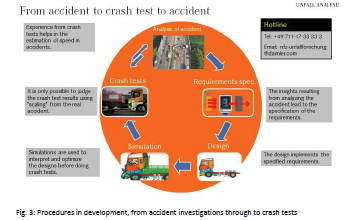EVU XXIII 2014-06 A manufacturer’s analysis of accidents involving commercial vehicles and the insights derived from that

Kay Morschheuser, Daimler AG
Summary
This paper will present a manufacturer’s work on the analysis of accidents, not only showing how and why, but also showing the effects that the results of the analyses have on the design and equipment of future series of vehicles. I would particularly like to show the way that the accident investigation team works, the areas that they concentrate on and the information that they feed back into the vehicle development process.
In the second part of the presentation, I would like to briefly show how the various driver assistance systems work. I would also like to show the characteristics and possible differences between driver assistance systems using examples, to show experts in the field the range of effects that systems like this can have. This information is of particular value when attempting to reconstruct what happened during an accident.
I will show how information is gathered, how vehicles are examined in situ, what data is acquired and how it is processed using special databases. I will also like to show which data is recorded in addition to the generally available accident statistics and will explain why it is recorded. In some detail, I will describe the relationship between the analysis of accidents and crash tests. Some examples will help to explain how the results of analyzing an accident flow into the process of developing vehicles.
We will also take a look at the need for driver assistance systems as a result of the observations from accidents. And, I will also show you how the various driver assistance systems work.
For the main causes of accidents already pointed out in the FAT paper on “The course of accidents involving heavy commercial vehicles”, I would like to offer some further insights and additions. I will show the need for manufacturers to analyze accidents internally. I will conclude with an explanation of how driver assistance systems work, the differences between them and the characteristics of systems like this.
Testo completo della pubblicazione scientifica disponibile ai soli iscritti.
| Autore | Kay Morschheuser, Daimler AG |
| Pubblicato il | |
| Tipologia |
